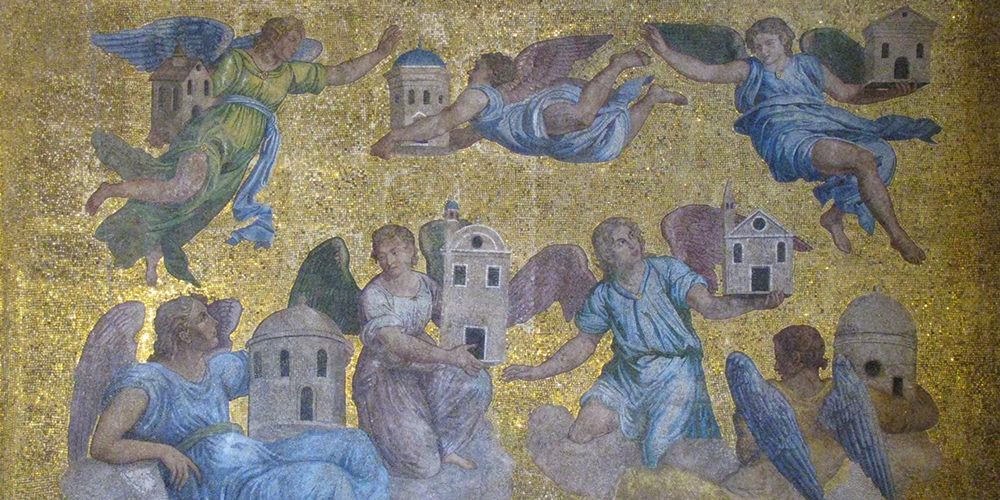Seven churches of Asia
The Seven Churches of Revelation, also known as The Seven Churches of the Apocalypse and The Seven Churches of Asia (referring to the Roman province of Asia, not the entire continent), are seven major churches of Early Christianity, as mentioned in the New Testament Book of Revelation. In early part of the Revelation, on the Greek island of Patmos, Jesus Christ instructs his servant John of Patmos, through an angelic intermediary, to: “Write on a scroll what you see and send it to the seven churches: to Ephesus, and to Smyrna, and to Pergamum, and to Thyatira, and to Sardis, and to Philadelphia, and to Laodicea.”
“Churches” in this context refers to the community or local congregations of Christians living in each city, and not merely to the building or buildings in which they gathered for worship.
Character of the churches
Ephesus (Revelation 2:1-7) – the church that had forsaken its first love (2:4)
Smyrna (Revelation 2:8-11) – the church that would suffer persecution (2:10)
Pergamum (Revelation 2:12-17) – the church that needed to repent of allowing false teachers (2:16)
Thyatira (Revelation 2:18-29) – the church that had a false prophetess (2:20)
Sardis (Revelation 3:1-6) – the church that had fallen asleep and yet called itself awake (3:2)
Philadelphia (Revelation 3:7-13) – the church that had endured patiently (3:10)
Laodicea (Revelation 3:14-22) – the church that was lukewarm and insipid (to God) (3:16)
Seven messages
The letters follow a common pattern. For example: the Lord first addresses each church and identifies himself, then defines things that he knows about the church in question. After this a challenge or reproach is given, followed by a promise. In all seven cases the admonition is included, “He who has an ear, let him hear what the Spirit says to the churches”, although sometimes this comes before the promise and sometimes after.
Although the letters differ in length in accord with the needs of each community, all conclude with an appeal to hold fast and to listen to what the Spirit is saying to the churches. Each church is promised that everyone who conquers will be rewarded by Christ.
Some historicists typically interpret the seven churches as representing seven different periods in the history of the Western Church from the time of Paul until the return of Jesus Christ.Scofield states that “these messages by their very terms go beyond the local assemblies mentioned.” He is of the opinion that the letters have a prophetic purpose disclosing the seven phases of the spiritual history of the Church. Other writers, such as Clarence Larkin, Henry Hampton Halley, Merrill Unger, and William M. Branham also have posited the view that the seven churches preview the history of the global Church.
Historicism has been criticized by the Eastern Orthodox Fr. Dimitri Cozby, who writes that historicists take a greatly oversimplified view of church history: “Since dispensationalism is Protestant in origin its ‘Church history’ is strictly Western. The dispensations take into account almost nothing of Orthodox history after the period of the early councils which we share with the West.”
Angels of the churches
Chapters 2-3 of the Revelation has specific messages for each of the seven churches. The message of each of the seven letters is directed to the angel of the particular church that is mentioned. Origen explains that these “angels” are the guardian angels of the churches, a view upheld by Henry Alford. But Epiphanius explicitly rejects this view, and, in accordance with the imagery of the passage, explains it of the bishops.
John sees a vision of the Son of Man, who walks among seven lampstands and has seven stars in his right hand. Revelation 1:20 states that “The seven stars are the angels of the seven churches, and the seven lampstands are the seven churches.” The comparison of a teacher to a star is scriptural.
Augustine of Hippo’s reason for interpreting angels of the churches as the prelates of the church is that St. John speaks of them as falling from their first charity which is not true of the angels. Others would say that the falling away relates to the churches, not to the messengers, as each of the seven letters conclude with the words “He who has an ear, let him hear what the Spirit says to the churches.”
In the New Testament, the Greek word for angels (άγγελος) is not only used for heavenly angels, but also used for human messengers, such as John the Baptist (Matthew 11:10,Mark 1:2,Luke 7:27) and God’s prophets (Revelation 22:8-9) C.I. Scofield has noted that “The natural explanation of the ‘messengers’ is that they were men sent by the seven churches to ascertain the state of the aged apostle … but they figure any who bear God’s messages to a church.”

